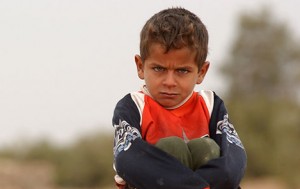
By G. Daniel Harden, Ph. D.*
A couple of summers ago, an old building in Topeka, Kansas was razed by a spectacular implosion.
Read the popular article: We Must Resist the Temptation to Secession
It was a large, 14-story structure, a minor landmark in the downtown area, and the event was scheduled for a Sunday morning so as not to interfere with traffic and commercial activity. Although the implosion was to be televised, the police identified good observation points for the public.
One of our sons and his family were visiting for the weekend, and my wife and I thought that witnessing the implosion would appeal to our two grandsons. But when their father asked if they would like to watch a large building collapse, their response was, “Is it going to be boring?” They chose to stay home.
Now, these boys are good kids. They do well in school, are relatively responsible, and I’m sure they will grow up to be productive citizens. But their response raises some essential questions about today’s children. Increasingly reared in a fast-paced technological environment, are they becoming adults with little inclination or capacity for contemplation and reflection?
As educators, we’ve all heard youngsters complain about one thing or another in school as being boring. But we now seem to have a lot of children in flight from what they perceive as pervasive boredom. Only within the context of a high-tech fantasyland can we maintain their interest. How has this situation come to be? As school administrators, teachers and parents, what can we do about it?
Why they’re bored
Many of the experiences that children once enjoyed, and which fastened a sense of awe have been deconstructed in modern society to the level of activities. We tend to assume, for example, that children cannot appreciate the beauty of a snow-covered hill for more than 10 or 15 seconds, so we quickly herd them into an activity like sledding or tobogganing that will keep them occupied for 20 minutes or so before it is supplanted by some other activity.
Children, as a result of frequent exposure to intense but artificial stimuli, may be unable to react to the wonders of the natural world. Many of today’s youth have never experienced such simple joys as walking through the woods in the fall with a friend, or even alone, feeling the crunch of crisp leaves underfoot and breathing deeply the pungent scents of autumn. Perhaps the bump-a-minute excitement of the Power Rangers and Teenage Mutant Ninja Turtles has made the pace of reality seem too slow.
Jacques Barzun was not far off when he stated in 1987, “…during the last 50 years, nearly everything done in school has tended toward the discontinuous, the incoherent, the jiggly.”
Why have educators succumbed to the need to entertain, to appeal to the 17.5-second attention span that typifies children’s television? Have we relegated the primary purpose of education; the development of critical, sustained rational thinking to the back burner?
Children today often lack the sort of adult guidance that helps develop a sense of awe, wholesome joy, and thoughtful appreciation. Although some children seem to have an innate notion of beauty and connectedess to the natural world, most learn from day-to-day examples and personal contact. But many parents and other adults are too busy to instill and nurture the reflective process in their children. I see two reasons for this.
First, the demands of the modern lifestyle are time-consuming, even all consuming, for many parents—as is earning enough to support it. In many affluent families, children are frequently taken to after-school lessons. While one might conclude that such children are probably better off than those who are ignored and left to their own impulses, somehow a community of guitar and karate instructors seems less organic, less reflective, and less authentic than one of parents, grandparents, aunts, uncles, and cousins.
Many parents themselves have developed little capacity for reflection and awe.
As Saint Thomas Aquinas said in the thirteenth century, “One cannot give what one does not have.” As a result, the closest that some young people come to expressing awe is, “Hey, that’s awesome, man!”
What we can do about it?
There have been a number of suggestions from many different sources and perspectives on how to deal with the related problems of short attention spans and hyperactivity.
While it is surely true that most jiggly children we see in school have simply never been taught by responsible adults the need to discipline their normal chaotic impulses, there are those who feel that the inability of so many children to focus and quietly reflect is not the result of child-rearing or school instructional practices. Rather, the cause is physiological, having something to do with children’s brain chemistry.
So what can we do?
We could give Ritalin to everyone. Whatever the cause, children’s behavior does seem to respond to this drug, for which demand has almost tripled since 1990. There are those who would propose that everyone, students and teachers alike would be more focused and productive if they were on a chemical regimen designed for that purpose.
We could restrict TV watching. Psychiatrist Sam Nigro has observed that children who spend great amounts of time watching TV exhibit many of the same posttraumatic stress disorder characteristics as returning veterans: increased irritability, inability to focus attention for extended periods of time, and generally erratic behavior.
Nigro urges American parents to pull the plug on television and Nintendo, and start talking to their children. The two-way conversation that is natural between the child and parent or close friend is impossible to duplicate with any technological device. Even good children’s television is at best a recreation of partial reality, with a message that is often distorted.
In 1947, Richard Weaver in his book, Ideas Have Consequences, described the impact of the mass media, observing their affinity for the sensational and coarse.
When popular culture is dependent on such mass media, society itself becomes hooked on the sensational and the coarse.
We could reevaluate our priorities. There have been a number of books written in the last two decades about how smaller is better—how a more austere lifestyle is superior to the opulence that most of us strive for in the late twentieth century. But such a change need not be severe. Perhaps parents could take evening walks with their children instead of spending time at the local physical fitness center. Or they could spend half an hour on a clear night trying to identify stars and constellations, while passing on to their children the ancient myths associated with the heavens. Together, they could go fishing or fossil hunting, or visit an elderly person.
We could bring back the family dinner: Although it may be difficult to do because of conflicting schedules, reintroducing the family dinner is important. Not only should the family try to have at least one meal a day together, but it should be an occasion for politeness and good behavior. Many young people know nothing about the importance of self-control and reserve because appropriate behavior has never been demanded of them. The family dinner table is a good place to start demanding and demonstrating better manners, appropriate dress, and meaningful conversation.
The question, “Is it going to be boring?” should not surprise us, considering the world we live in. We have to choose whether to simply continue the bump-a-minute conditions shaping childhood experience today, or take steps to change that environment to one that ratchets down, replacing chaos with order and encouraging reflection.
live in. We have to choose whether to simply continue the bump-a-minute conditions shaping childhood experience today, or take steps to change that environment to one that ratchets down, replacing chaos with order and encouraging reflection.
Considering the trends of the time, it is probably too much to hope that such a change will ever become a national goal. But if parents start thinking about how to create an orderly and focused environment for their children, and principals and teachers start thinking about the need for student reflection, we may be able to help a lot of young people.


